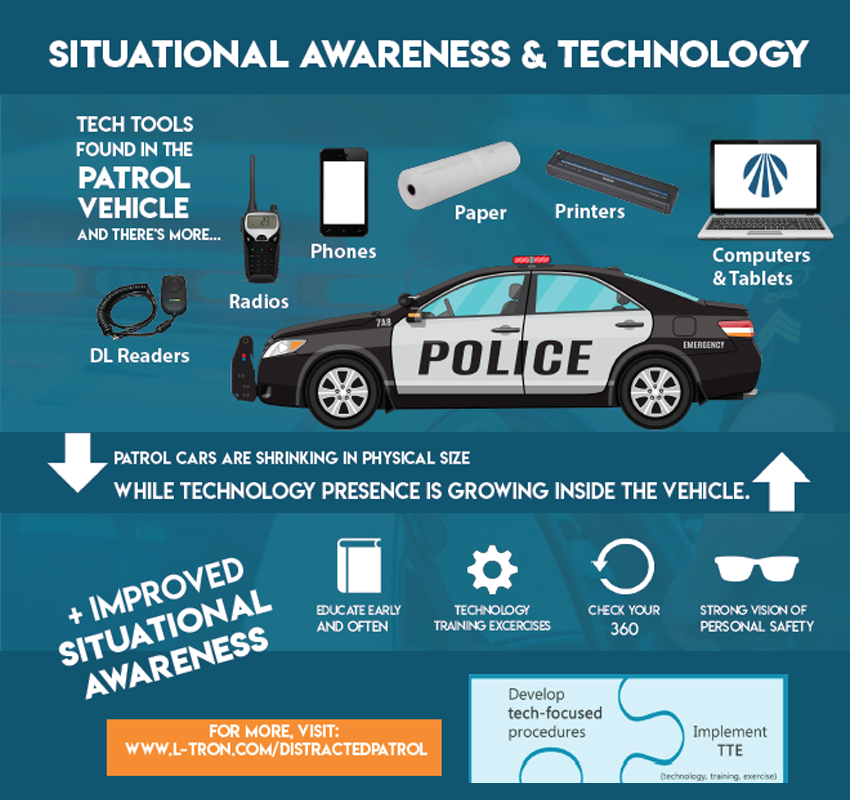Thinking. The best protection for most distracted motorists on the road.
If you’re a street cop you observe approaching vehicles, plates, stickers, drivers, passengers, and unique characteristics. Not much to absorb in a glance, right?
Patrol is full of distractions and distracted police driving is real.
Since you can’t really patrol from one spot, you drive. Distracted. There’s actually a formula for police officers’ ability to drive distracted … experience over time, plus muscle memory, equals eventual second nature.
Add the interior of your patrol car.
Radios. Radar. Computer. Video camera. Printer. Cell phone. Bluetooth. Sometimes more than one cell phone. In newer cars, add heads-up displays. All packed into your mobile office.
Take a look at this situational awareness infographic below:
Throw in some variables.
Outside, there’s weather, traffic, speed, road surfaces, crowded parking lots, construction, pedestrians, and other distracted drivers. In and on your patrol car – lights, siren, rifle, shotgun, prisoner cage, that unknown something rolling around on the floor left over from the previous shift … oh, it’s the 4910LR DL reader and registration scanner from L-Tron Corporation. (There’s now a magnetic mount for that too.)
Then there’s you. Body armor, gun belt, handgun, whatever you carry on the belt, portable radio and shoulder mic, bodycam, hunger, indigestion, coffee, spit cup (ick!), food, this morning’s fight with the spouse, the pending follow-up investigations hanging over your head.
Fatigue.
And you’ve needed to find a bathroom for the past two hours. Think you’re distracted?
You’re one of the thousands of police officers responsible for holding the line on distracted driving. You, your patrol unit, and the almighty traffic ticket are relied upon to prevent the injuries and fatalities which accompany the phenomenon. Think you’re distracted?
Objects, thoughts, emotions – your entire internal and external environment – hinders sight lines, impacts your flexibility, visibility, and diverts your attention.
Unknowingly, your driving ability is being affected.
As uncomfortable as a mobile office is, police officers can lull themselves into an unintentional cocoon of comfort. I argue THAT comfort, that familiarity within an operating environment, tricks cops into thinking they can drive, listen and talk to the dispatcher, operate the computer, keep their eyes on the road, and REACT to most anything.
Police officers know better than anyone that REACTION to anything is already a losing proposition. Compounding reactions are the rules – departmental general orders, regulations, supervisors’ expectations, job performance standards, public perception, civil liability, OSHA – real mental distractions. I haven’t even mentioned age yet and its impact on reaction time. Typically, as we age, we slow down.
Ironically, that’s the solution to the problem. Slowing down. And thinking. Sounds elementary. It isn’t.
Focusing on your driving, which is only part of the job of patrol, requires BEING PRESENT. That means concentration, practiced muscle memory, and training. It’s nearly impossible to do, but somehow police officers manage to successfully, (usually safely) navigate our roadways and get the job done.
As humans, we tend to overcomplicate things. Cops HATE complications.
So, here’s three simple facts – the “data” as we love to say in the tech industry:
- 12 of this year’s 38 police fatalities (as of April 16th) were traffic-related incidents. That’s 32%.
- 35% of police officers killed in 2017 were by traffic-related incidents according to the National Law Enforcement Officers Memorial Fund – that includes auto crashes, motorcycle crashes, and those struck by vehicles.
- In 15 of the 20 years from 2000 to 2015, traffic-related incidents were THE leading cause of death to police officers (NLEOMF).
Cops LOVE simple solutions.
There’s no cure for law enforcement hazards, but we CAN reduce risk. Let’s leave it at this:
- Be mindful of your driving. Be present. Leave home at home. Concentrate on the task at hand. That means being aware of your surroundings, putting the cell phone down, planning ahead when responding to a hot call, and pulling off the road to use the car computer.
- Slow down. No, you DON’T need to go to every call with the pedal to the metal, with lights and siren, and your blinders on. Stop, look and clear ALL intersections when under emergency operation.
- Wear your seatbelt. And your body armor. And your traffic vest. Each in its own way will protect you in vehicle-related incidents.
- Control where you pull cars over and be attentive to your patrol car placement and mindful of your surroundings, whether a traffic stop, car crash, or any other incident.
- Use passenger side vehicle approaches when appropriate.
I inadvertently hit four of the five planks of the Below 100 initiative aimed at keeping law enforcement officer deaths under that benchmark. Police expert Gordon Graham of LEXIPOL has five great, very brief videos which outline the Below 100 mindset which will keep you safe. Click to watch them here.
Last best advice for eliminating your police driving distractions? Never pass up a bathroom opportunity.
Be safe.
For more information on distracted driving and distractions in the patrol car, visit our Situational Awareness website here.
Questions?
Call 800-830-9523 or Email info@L-Tron.com
